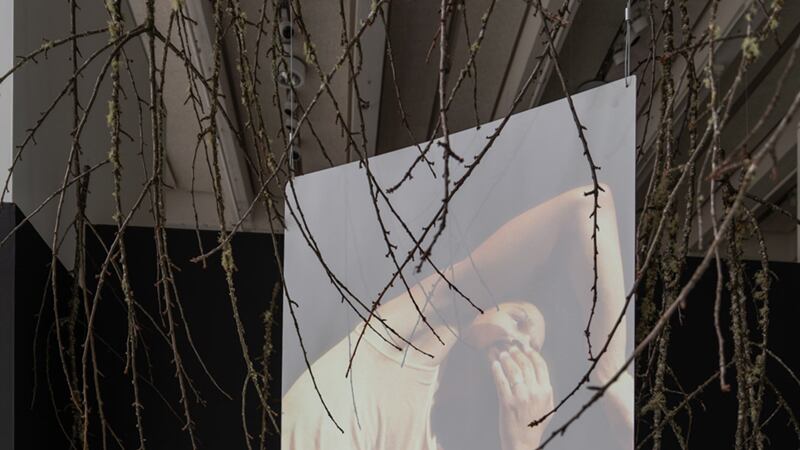The dizzying array of influences animating Shelter in Place, Adam McKinney's stunning multimedia display for the Oregon Jewish Museum and Center for Holocaust Education, reflects both the diverse heritage of its gay Jewish, Native, African American creator and the unprecedented challenges wrought by COVID-19. An assistant professor of dance at Texas Christian University and classically trained performer whose background includes stints with the Alvin Ailey American Dance Theater in New York City and Switzerland's Bejart Ballet Lausanne, McKinney had already immersed himself in projects centered on the 1921 lynching of Fred Rouse in Fort Worth, Texas.
Shelter in Place features footage of McKinney dancing as Rouse alongside projected poetry, artful décor that pays homage to the Jewish holiday Sukkot, and new hologram film Glorious Clouds—an ecstatic representation of the providential skies that accompanied the Israelites' exodus from Egypt.
While readying the December premiere of his Fort Worth Lynching Tour—a bicycle journey of Rouse's final night—McKinney spoke with WW about the meanings layered within Shelter in Place as well as the difficulties of assembling an installation he's not yet been able to visit.
WW: What's the best way to approach the display as a viewer?
Adam McKinney: There's no one way to experience Shelter in Place. My goal is that everyone will connect to some element, and I offer these multiple avenues of entry for viewers so that they connect with perhaps the imagery, perhaps the music, perhaps the branches that wind and weave and coil throughout the space coming to a climax in the corner where the Glorious Clouds film plays, and these seemingly disparate sides come together as one full identity.
What do the branches symbolize?
The lynching of Mr. Rouse, but they're also connected to the holiday of Sukkot. It commemorates the harvest and exodus and happiness. We build dwellings outside our homes and synagogues and schools, in which some eat and sleep and pray, and place branches on the ceilings so that we can see the stars above. They're representative of the clouds of glory that God sent the Israelites after they left Egypt. But Shelter in Place is also representative of this particular moment when we're working to reconcile histories of the enslavement of Black people. There's an urgency to heal, to move in the direction of each other, and that's really hard because COVID-19 is not allowing that to happen as needed. Shelter in Place is an inversion of the Sukkot to bring the inside out.
As Oregonians, we have to ask, what sort of wood did you use?
My goal was hackberry, the type of tree from which Mr. Rouse was hanged, but I couldn't locate any. A cousin in Portland hooked me up with Flamingo Farms near Vancouver. They took pictures of some cherry branches and gave me a good price. It was all very serendipitous. Being so distant from the process, I had to make really clear, fast decisions just trusting that this huge experiment would all work out, and I think it did—beautifully.
Had you been to the museum before?
Never. When I danced with a ballet company in San Francisco, we toured Portland, and I had some familiarity with the area.
And you could look around virtually?
I was already thinking about transportation—transporting my body across time and space. Since I can't travel to Portland, how can I end up performing this work there? I have this project looking at the history of colonialism by using subversion of border technology to bring people closer together—drone technology, for instance—and the idea of holograms was an exciting one for me. We worked with different types of technology to try and make that happen—mirrors, plexiglass—but it ended up as a dance film projected onto white vinyl. I've been in contact with other museums in North America about restaging this work. Shelter in Place has legs, and I hope that the holograms will be able to happen elsewhere.
Were the downtown protests a consideration when assembling this project?
Absolutely. Shelter in Place was not created in a vacuum. Thinking about the history of white supremacy [in Portland], I regularly checked in with my contact to inform the direction of the work and ensure that what I was doing was both in response to and part of what was happening there.
Did you target visitors who would knowingly come to view the exhibit or random passersby?
It's for anybody and everybody. The intention for Shelter in Place was to maintain safety and social distancing, but coming upon it should feel like an exposé—kind of pulling back the curtain, you know? One needs to look a little closer and a little deeper.
SEE IT: Shelter in Place is in the windows and first-floor gallery of the Oregon Jewish Museum and Center for Holocaust Education, 724 NW Davis St., ojmche.org. Through Friday, Nov. 20.

